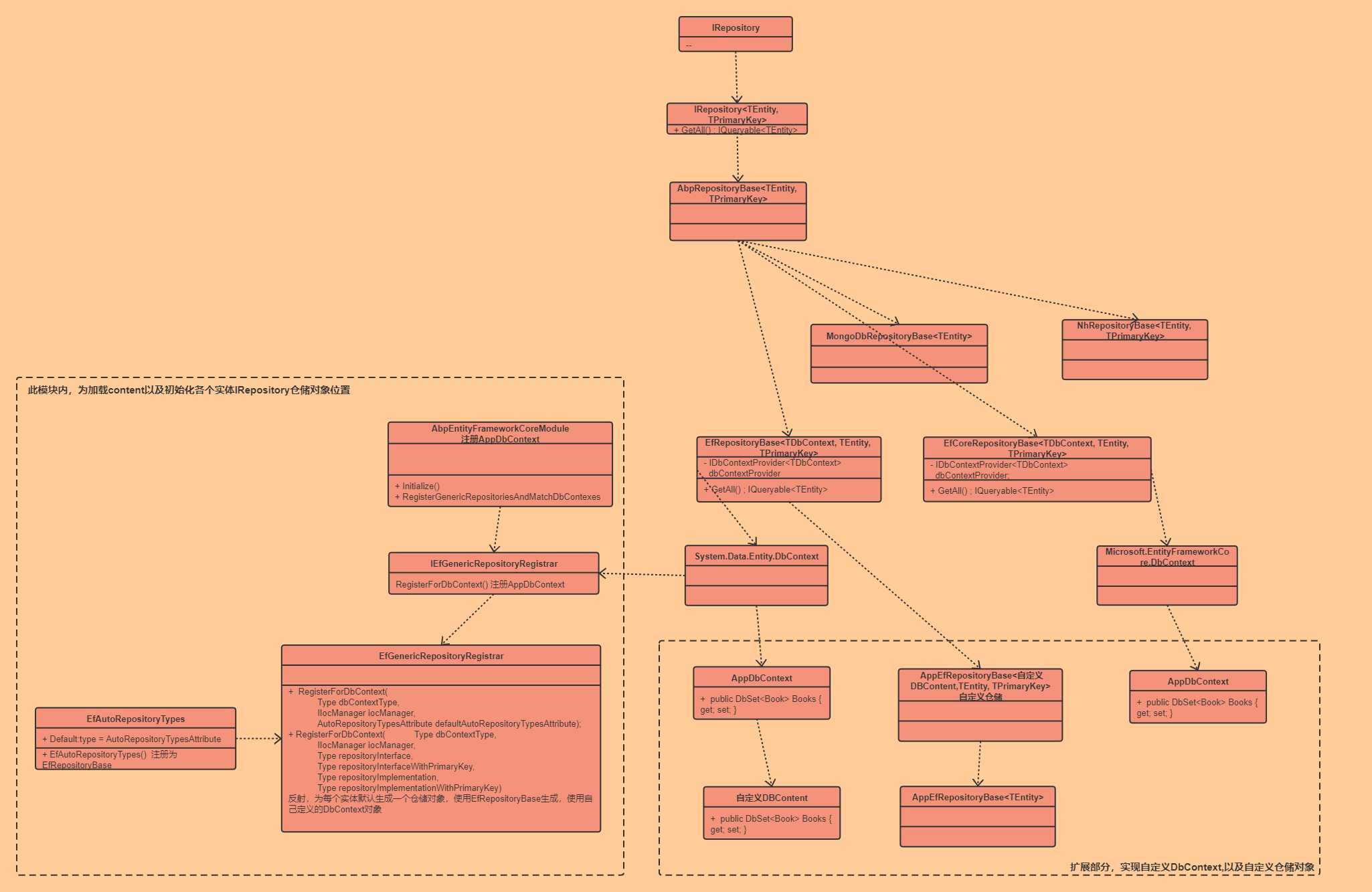ABP 数据访问 - IRepository 仓储
ABP系列,这个系列来的比较晚,很多大佬其实已经分析过,为什么现在我又来一轮呢?
1.想自己来完整的学习一轮ABP
2.公司目前正在使用ABP,准备迁移Core
基于以上的目的,开始这个系列
ABP IRepository
先上 IRepository 类图结构
只是描述了类的关联关系,很多成员并不准确

基于这个类图,我们再来分析下ABP的仓储访问;
1.IRepository 整体结构
按照我的理解,可以简单分为三部分;
1.整体接口以及抽象父类定义
2.自定义DbContext,Repository,实体
3.自动注册实体仓储
1.整体接口以及抽象父类定义
这部分内容整体包含在IRepository,IRepository<TEntity,TprimaryKey>,AbpRepositoryBase中,也就是图中为包含在虚线框的内容;
IRepository:仓储的接口,接口中未定义方方法
IRepository<TEntity, TPrimaryKey> :定义仓储对象的相关查询方法,GetAll(),Get()等方法
AbpRepositoryBase<TEntity, TPrimaryKey> :抽象类,封装了一些公共方法但是并未有具体实现,实现留在了具体的调用层,例如 EF,EfCore,Dapper等
接口实现
EfCoreRepositoryBase<TDbContext, TEntity, TPrimaryKey> :
实现AbpRepositoryBase<TEntity, TPrimaryKey>
1.EFCore的内部核心查询全部就依赖于 DbContext,DbSet来操作数据;
2.EFCore的DbContext引用来源Microsoft.EntityFrameworkCore.DbContext,而Ef的DbContext依赖引用System.Data.Entity.DbContext,Core的底层依赖就全部替换了
AbpDbContext :ABP默认的EFCore的DBContext封装,包含一些公共方法,要在ABP框架下使用DbContext,需要继承 AbpDbContext
2.自定义DbContext,Repository,实体
实现DBContext:
public class SampleAppDbContext : AbpZeroDbContext<Tenant, Role, User, SampleAppDbContext>, IAbpPersistedGrantDbContext
{
public DbSet<PersistedGrantEntity> PersistedGrants { get; set; }
public DbSet<Advertisement> Advertisements { get; set; }
public DbSet<Blog> Blogs { get; set; }
public DbSet<Post> Posts { get; set; }
public DbSet<Category> Categories { get; set; }
public DbSet<Comment> Comments { get; set; }
public DbSet<Product> Products { get; set; }
public DbSet<ProductTranslation> ProductTranslations { get; set; }
public DbSet<Author> Authors { get; set; }
public DbSet<Store> Stores { get; set; }
public DbSet<Order> Orders { get; set; }
public DbSet<OrderTranslation> OrderTranslations { get; set; }
public DbSet<UserTestEntity> UserTestEntities { get; set; }
public DbSet<Country> Countries { get; set; }
public SampleAppDbContext(DbContextOptions<SampleAppDbContext> options)
: base(options)
{
}
protected override void OnModelCreating(ModelBuilder modelBuilder)
{
base.OnModelCreating(modelBuilder);
modelBuilder.ConfigurePersistedGrantEntity();
modelBuilder.Entity<Blog>().OwnsOne(x => x.More);
modelBuilder.Entity<Blog>().OwnsMany(x => x.Promotions, b =>
{
b.WithOwner().HasForeignKey(bp => bp.BlogId);
b.Property<int>("Id");
b.HasKey("Id");
b.HasOne<Blog>()
.WithOne()
.HasForeignKey<BlogPromotion>(bp => bp.AdvertisementId)
.IsRequired();
});
modelBuilder.Entity<Advertisement>().OwnsMany(a => a.Feedbacks, b =>
{
b.WithOwner().HasForeignKey(af => af.AdvertisementId);
b.Property<int>("Id");
b.HasKey("Id");
b.HasOne<Comment>()
.WithOne()
.HasForeignKey<AdvertisementFeedback>(af => af.CommentId);
});
modelBuilder.Entity<Book>().ToTable("Books");
modelBuilder.Entity<Book>().Property(e => e.Id).ValueGeneratedNever();
modelBuilder.Entity<Store>().Property(e => e.Id).HasColumnName("StoreId");
}
}
}
DbContext中需要定义实体的DBSet,因为数据操作都是基于DbSet来完成
个性化仓储:
第一步,设置自定义仓储接口
public interface IPostRepository : IRepository<Post, Guid>
{
}
这里继承IRepository<Entity,PrimaryKey>,说明实体主键并非Int类型,所以需要重新实现
第二步,继承 EfCoreRepositoryBase,实现自定义仓储方法
public class PostRepository : EfCoreRepositoryBase<BloggingDbContext, Post, Guid>,
IPostRepository
{
public PostRepository(IDbContextProvider<BloggingDbContext> dbContextProvider)
: base(dbContextProvider)
{
}
public override int Count()
{
throw new Exception("can not get count of posts");
}
}
第三步,注册自定义仓储,注册代码写在自定义模块中
注意:自定义模块的注册必须依赖 AbpEntityFrameworkCoreModule 模块先注册 这里留着后面来解释,为什么一定要依赖
//Custom repository
Configuration.ReplaceService<IRepository<Post, Guid>>(() =>
{
IocManager.IocContainer.Register(
Component.For<IRepository<Post, Guid>, IPostRepository,
PostRepository>()
.ImplementedBy<PostRepository>()
.LifestyleTransient()
);
});
3.自动注册实体仓储
首先来看下,我们定义好DbContext后,如果使用自己的仓储服务呢?
在类里面定义属性仓储
private readonly IRepository<EntityDynamicParameter> _entityDynamicParameterRepository;
大家有没有考虑过,为什么我们可以直接使用实体的仓储类,在哪里实例化的呢? 这是ABP自动完成的,会反射获取所有的实体服务,并自动为其注册仓储服务,我们一起来分析下自动注册的内容
AbpEntityFrameworkCoreModule.cs
public override void Initialize()
{
IocManager.RegisterAssemblyByConvention(typeof(AbpEntityFrameworkCoreModule).GetAssembly());
IocManager.IocContainer.Register(
Component.For(typeof(IDbContextProvider<>))
.ImplementedBy(typeof(UnitOfWorkDbContextProvider<>))
.LifestyleTransient()
);
RegisterGenericRepositoriesAndMatchDbContexes();
}
调用 RegisterGenericRepositoriesAndMatchDbContexes 方法
private void RegisterGenericRepositoriesAndMatchDbContexes()
{
var dbContextTypes =
_typeFinder.Find(type =>
{
var typeInfo = type.GetTypeInfo();
return typeInfo.IsPublic &&
!typeInfo.IsAbstract &&
typeInfo.IsClass &&
typeof(AbpDbContext).IsAssignableFrom(type);
});
if (dbContextTypes.IsNullOrEmpty())
{
Logger.Warn("No class found derived from AbpDbContext.");
return;
}
using (IScopedIocResolver scope = IocManager.CreateScope())
{
foreach (var dbContextType in dbContextTypes)
{
Logger.Debug("Registering DbContext: " + dbContextType.AssemblyQualifiedName);
scope.Resolve<IEfGenericRepositoryRegistrar>().RegisterForDbContext(dbContextType, IocManager, EfCoreAutoRepositoryTypes.Default);
IocManager.IocContainer.Register(
Component.For<ISecondaryOrmRegistrar>()
.Named(Guid.NewGuid().ToString("N"))
.Instance(new EfCoreBasedSecondaryOrmRegistrar(dbContextType, scope.Resolve<IDbContextEntityFinder>()))
.LifestyleTransient()
);
}
scope.Resolve<IDbContextTypeMatcher>().Populate(dbContextTypes);
}
}
1.首先加载所有的AbpDbContext
2.对AbpDbContext循环进行注册
这里的注册依赖接口
scope.Resolve().RegisterForDbContext(dbContextType, IocManager, EfCoreAutoRepositoryTypes.Default);
我们来看下这个具体实现逻辑,依赖接口 IEfGenericRepositoryRegistrar
EfGenericRepositoryRegistrar.cs
public void RegisterForDbContext(
Type dbContextType,
IIocManager iocManager,
AutoRepositoryTypesAttribute defaultAutoRepositoryTypesAttribute)
{
var autoRepositoryAttr = dbContextType.GetTypeInfo().GetSingleAttributeOrNull<AutoRepositoryTypesAttribute>() ?? defaultAutoRepositoryTypesAttribute;
RegisterForDbContext(
dbContextType,
iocManager,
autoRepositoryAttr.RepositoryInterface,
autoRepositoryAttr.RepositoryInterfaceWithPrimaryKey,
autoRepositoryAttr.RepositoryImplementation,
autoRepositoryAttr.RepositoryImplementationWithPrimaryKey
);
if (autoRepositoryAttr.WithDefaultRepositoryInterfaces)
{
RegisterForDbContext(
dbContextType,
iocManager,
defaultAutoRepositoryTypesAttribute.RepositoryInterface,
defaultAutoRepositoryTypesAttribute.RepositoryInterfaceWithPrimaryKey,
autoRepositoryAttr.RepositoryImplementation,
autoRepositoryAttr.RepositoryImplementationWithPrimaryKey
);
}
}
private void RegisterForDbContext(
Type dbContextType,
IIocManager iocManager,
Type repositoryInterface,
Type repositoryInterfaceWithPrimaryKey,
Type repositoryImplementation,
Type repositoryImplementationWithPrimaryKey)
{
foreach (var entityTypeInfo in _dbContextEntityFinder.GetEntityTypeInfos(dbContextType))
{
var primaryKeyType = EntityHelper.GetPrimaryKeyType(entityTypeInfo.EntityType);
if (primaryKeyType == typeof(int))
{
var genericRepositoryType = repositoryInterface.MakeGenericType(entityTypeInfo.EntityType);
if (!iocManager.IsRegistered(genericRepositoryType))
{
var implType = repositoryImplementation.GetGenericArguments().Length == 1 ? repositoryImplementation.MakeGenericType(entityTypeInfo.EntityType) : repositoryImplementation.MakeGenericType(entityTypeInfo.DeclaringType,
entityTypeInfo.EntityType);
iocManager.IocContainer.Register(
Component
.For(genericRepositoryType)
.ImplementedBy(implType)
.Named(Guid.NewGuid().ToString("N"))
.LifestyleTransient()
);
}
}
var genericRepositoryTypeWithPrimaryKey =
repositoryInterfaceWithPrimaryKey.MakeGenericType(entityTypeInfo.EntityType,primaryKeyType);
if (!iocManager.IsRegistered(genericRepositoryTypeWithPrimaryKey))
{
var implType =
repositoryImplementationWithPrimaryKey.GetGenericArguments().Length == 2? repositoryImplementationWithPrimaryKey.MakeGenericType(entityTypeInfo.EntityType, primaryKeyType) : repositoryImplementationWithPrimaryKey.MakeGenericType(entityTypeInfo.DeclaringType, entityTypeInfo.EntityType, primaryKeyType);
iocManager.IocContainer.Register(
Component
.For(genericRepositoryTypeWithPrimaryKey)
.ImplementedBy(implType)
.Named(Guid.NewGuid().ToString("N"))
.LifestyleTransient()
);
}
}
}
来分析下具体的实现逻辑
foreach (var entityTypeInfo in _dbContextEntityFinder.GetEntityTypeInfos(dbContextType))
_dbContextEntityFinder.GetEntityTypeInfos(dbContextType) 这里获取的就是DbContext定义的实体DbSet,从而获取到每个实体,用来做后续的仓储注入;例如:获取到了 PersonEntity
var primaryKeyType = EntityHelper.GetPrimaryKeyType(entityTypeInfo.EntityType);
获取实体主键
if (primaryKeyType == typeof(int))
判断主键是否为int,如果是int,则继承 IRepository,否则继承IRepository<Entity,PrimaryKey>用来重写主键
那是通过什么类来实现的IRepository呢?
public static AutoRepositoryTypesAttribute Default { get; }
static EfCoreAutoRepositoryTypes()
{
Default = new AutoRepositoryTypesAttribute(
typeof(IRepository<>),
typeof(IRepository<,>),
typeof(EfCoreRepositoryBase<,>),
typeof(EfCoreRepositoryBase<,,>)
);
}
这是默认的实体继承的仓储类,EfCoreRepositoryBase 类
好了,实体的默认仓储就介绍完毕了。。。 不对啊,这里可以满足我们的DbContext里面所有的实体,但是万一有了自定义仓储呢?怎么注册自己的仓储呢?
哈哈,其实还是有个方法的,而且还不只一个。。。
1.DbContext打标记,用来替换默认的AutoRepositoryTypesAttribute
[AutoRepositoryTypes(
typeof(IMyModuleRepository<>),
typeof(IMyModuleRepository<,>),
typeof(MyModuleRepositoryBase<>),
typeof(MyModuleRepositoryBase<,>)
)]
2.第二种就是替换已经注册的实体仓储服务
回到上面问题,AbpEntityFrameworkCoreModule 模块先注册 ? 其实上面写到了,在我们自定义的模块注册时,可以重新注册仓储服务
//Custom repository
Configuration.ReplaceService<IRepository<Post, Guid>>(() =>
{
IocManager.IocContainer.Register(
Component.For<IRepository<Post, Guid>, IPostRepository,
PostRepository>()
.ImplementedBy<PostRepository>()
.LifestyleTransient()
);
});
就是要必须在 AbpEntityFrameworkCoreModule 注册之后,否则就会被覆盖哦,这里也就呼应了上面的问题了
仓储三要素:
- 仓储的生命周期:仓储都是临时性的,需要的时候创建,用完销毁。
- 数据库的连接和管理仓储的方法中,数据库的连接和管理都是由ABP框架自动处理的。当方法被调用的时候,ABP自动开启数据库的连接同时开启事务,当方法结束后,ABP会将实体数据保存,然后断开连接。当在仓储方法中调用仓储方法的时候,此时只会创建一个数据库连接,他们共同享用数据库连接和事务,由最上层的那个仓储方法进行管理。
- 仓储的最佳实践在ABP框架初始化的时候已经为每一个实体类都默认的实现了相应的仓储,这些仓储里的方法基本可以满足日常的开发需求,所以不要自己手动创建仓储
ABP 数据访问 - IRepository 仓储的更多相关文章
- 基于 abp vNext 和 .NET Core 开发博客项目 - 数据访问和代码优先
上一篇文章(https://www.cnblogs.com/meowv/p/12909558.html)完善了项目中的代码,接入了Swagger.本篇主要使用Entity Framework Core ...
- ABP框架之——数据访问基础架构
大家好,我是张飞洪,感谢您的阅读,我会不定期和你分享阅读心得,希望我的文章能成为你成长路上的一块垫脚石,我们一起精进. 几乎所有的业务应用程序都要适用一种数据库基础架构,用来实现数据访问逻辑,以便从数 ...
- 同时支持EF+Dapper的混合仓储,助你快速搭建数据访问层
背景 17年开始,公司开始向DotNet Core转型,面对ORM工具的选型,当时围绕Dapper和EF发生了激烈的讨论.项目团队更加关注快速交付,他们主张使用EF这种能快速开发的ORM工具:而在线业 ...
- 项目架构开发:数据访问层之Repository
接上文 项目架构开发:数据访问层之Logger 本章我们继续IRepository开发,这个仓储与领域模式里边的仓储有区别,更像一个工具类,也就是有些园友说的“伪仓储”, 这个仓储只实现单表的CURD ...
- ASP.NET Core模块化前后端分离快速开发框架介绍之3、数据访问模块介绍
源码 GitHub:https://github.com/iamoldli/NetModular 演示地址 地址:https://nm.iamoldli.com 账户:admin 密码:admin 前 ...
- 数据访问层之Repository
数据访问层之Repository 接上文 项目架构开发:数据访问层之Logger 本章我们继续IRepository开发,这个仓储与领域模式里边的仓储有区别,更像一个工具类,也就是有些园友说的“伪 ...
- ABP领域层定义仓储并实现
原文作者:圣杰 原文地址:ABP入门系列(3)——领域层定义仓储并实现 在原文作者上进行改正,适配ABP新版本.内容相同 一.先来介绍下仓储 仓储(Repository): 仓储用来操作数据库进行数据 ...
- 数据访问模式之Repository模式
数据访问模式之Repository模式 数据访问层无非就是对数据进行增删改查,其中增.删.改等我们可以抽象出来写一个公共的接口或抽象类来定义这些方法,并采用一个基类实现这些方法,这样该基类派生的子 ...
- 项目架构开发:数据访问层之UnitOfWork
接上文 项目架构开发:数据访问层之IQuery 本章我们继续IUnitOfWork的开发,从之前的IRepository接口中就可以看出,我们并没有处理单元事务, 数据CUD每次都是立即执行的,这样有 ...
随机推荐
- 802.1X 账号密码+设备信息双重认证
名词解释 802.1X: IEEE802 LAN/WAN 委员会为解决无线局域网网络安全问题,提出了 802.1X 协议.后来,802.1X协议作为局域网端口的一个普通接入控制机制在以太网中被广泛应用 ...
- spring:spring再总结(ioc、aop、DI等)
IOC(Inversion of Control),即"控制反转",不是一种技术而是一种思想 1.IOC的理解 Ioc意味着将你设计好的对象交给容器控制,而不是传统的在你的对象内部 ...
- java原生程序redis连接(连接池/长连接和短连接)选择问题
最近遇到的连接问题我准备从重构的几个程序(redis和mysql)长连接和短连接,以及连接池和单连接等问题用几篇博客来总结下. 这个问题的具体发生在java原生程序和redis的交互中.这个问题对我最 ...
- spring cloud consul 服务治理
对照系统安装响应consul文件(以window为例) 解压文件之后配置环境,进入Path添加文件所在目录, 测试:在文件所在目录下进入指令操作 输入 consul agent -dev 启动成功,在 ...
- Spring学习(三)--Spring的IOC
1.BeanFactory和FactoryBean BeanFactory是一个接口类,定义了IOC容器最基本的形式,提供了IOC容器所应该遵守的基本服务契约. FactoryBean是一个能产生或者 ...
- STM32与CH455g通信测试(仅键盘)
1.概述 CH455是数码管显示驱动和键盘扫描控制芯片.CH455内置时钟振荡电路,可以动态驱动4位数码管或者32只LED:同时还可以进行28键的键盘扫描:CH455通过SCL和SDA组成的2线串行接 ...
- VUE第一个项目怎么读懂
VUE介绍 VUE是前端开发框架. 原始的前端开发需要工程师写html.写css.写javascript(js).js是脚本语言,浏览器可以运行js来执行一些js支持的动作,例如点击反馈,下拉菜单.操 ...
- ByPass Mode(略过模式或旁路模式)
参考: 1. https://baike.baidu.com/item/%E6%97%81%E8%B7%AF%E6%A8%A1%E5%BC%8F/3120563 2. https://zhidao.b ...
- c++缓冲区std::wstringbuf
参考:http://www.cplusplus.com/reference/sstream/wstringbuf/ class <sstream> std::wstringbuf type ...
- Java 实现截屏
操作系统:Windows 10 x64 参考:https://blog.csdn.net/weixin_40657079/article/details/83961708 1 import java. ...
